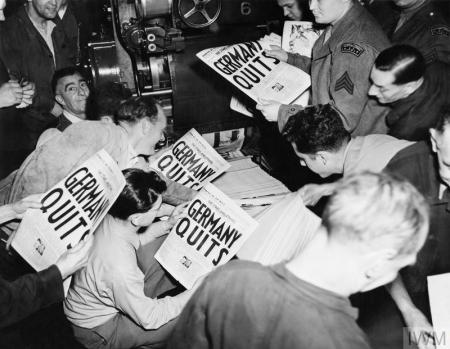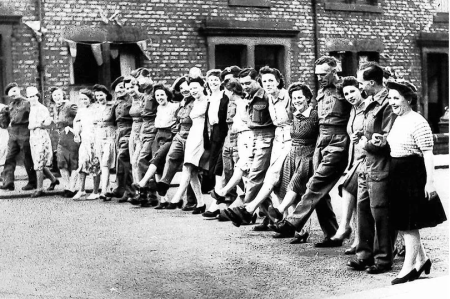Remember and reflect exhibition
Remember and reflect exhibition
Our Remember and reflect exhibition commemorates the eightieth anniversaries of VE Day and VJ Day.
The original exhibition, featured on this page, was originally on display in the Arches at the Civic Centre in May 2025 and focusses on the war in Europe.
We are currently creating new displays. These will focus on what happened after VE Day and will continue up to the 15 August 1945, the day Victory over Japan and the end of World War 2 were finally declared. This will include information on what the allied forces found when they liberated the concentration camps.
Remember and reflect will also feature ,and focus, on the Fourteenth Army possibly the most diverse fighting force ever, who are often referred to as the Forgotten Army.
The final Remember and remember exhibition will be on display in the Arches during August 2025 as part of our events to mark the eightieth anniversary of VJ Day.
War in Europe
Our Remember and reflect exhibition starts on 3 September 1939, the day World War 2 was declared, and currently ends on 8 May 1945, the day Victory in Europe was announced.
In Europe, World War 2 was a time of intense conflict and devastation. While the allied forces led by Great Britain, Russia and the USA (from 1941) defeated Nazi Germany and Fascist Italy the war resulted in the loss of at least 39 million lives.
Britain is at war
On 3 September 1939, two days after their troops invaded Poland, Britain declared war on Nazi Germany. At 11:15 am, Prime Minister, Neville Chamberlain, announced that Britain was at war in a live radio broadcast.

“This morning the British Ambassador in Berlin handed the German Government a final Note stating that, unless we heard from them by 11 o'clock that they were prepared at once to withdraw their troops from Poland, a state of war would exist between us.
Continued at 1939: Britain is at war
War in Europe begins
The defeat of Poland in September 1939, was followed by a period of stalemate in Western Europe as Britain and France faced a long and costly war with Germany.

During this time British and French plans were mainly defensive as it was taking a long time to build their land forces. The Allied naval blockade of Germany was seen as more important.
Continued at War in Europe begins.
Dunkirk evacuation
In May 1940, Germany attacked France taking just six weeks to overwhelm the Allied defence. British troops retreated to Dunkirk. A decision was made to arrange an evacuation instead of launching a counter attack.
%20-%20British%20troops%20line%20up%20on%20the%20beach%20at%20Dunkirk%20to%20await%20evacuation..jpg)
The Royal Navy planned a huge mission to rescue over 338,000 soldiers by getting them off the beaches and back to Britain.
Continued at Dunkirk evacuation.
Battle of Britain
After the evacuation of Dunkirk, Germany tried to gain air superiority ready for a planned invasion of Great Britain. The Battle of Britain was a decisive air campaign fought mainly over southern England in 1940.
%20Hawker%20Hurricanes%20of%20No.%2085%20Squadron%20in%20formation%2C%20seen%20from%20below%2C%20October%201940..jpg)
After France fell, Britain chose to fight on instead of seeking the peace deal Hitler had expected. Hoping to end the war quickly Hitler ordered his forces to prepare for an invasion of Britain, codenamed Operation Sealion. To succeed. the Germans needed to remove the threat of the RAF and take control of the skies over southern England.
Continued at Battle of Britain.
Newcastle Blitz
On 1 September 1939, 31,222 children from Newcastle were evacuated to rural parts of Northumberland, Cumberland and Yorkshire. They were followed on 2 September by, 12,919 mothers and young children.

By 1940 Hitler had identified Newcastle and north-east England as a strategic priority. Heavy industry and key transport routes including bridges, shipyards and the Elswick Works were targets. From April 1940 to December 1941 nearly 400 people died in bombing attacks referred to as the Newcastle Blitz.
Continued at Newcastle Blitz
D-Day
On 6 June 1944, Allied forces launched Operation Overlord and began the fight to liberate north-west Europe from German occupation. It was the largest amphibious invasion in the history of warfare.
%206th%20airborne%20division%2C%20Normandy%20coast%2C%2006.06.1944%20.jpg)
coast, 06.06.1944
A command team led by American General Dwight D. Eisenhower was formed in December 1943 to plan the naval, air and land operations. Deception campaigns were developed to draw German attention and strength away from Normandy.
Continued at D-Day
On the home front
For the first eight months there was little fighting in the war and the government were optimistic of a negotiated peace. Despite this unrealistic optimism they introduced wartime measures, such as the blackout and evacuation, that were very unpopular.
Blackout
Blackout was introduced on 1 September 1939, two days before war was declared. In the beginning even lighting a match could lead to a fine. This was later changed for a more realistic approach =but all lights had to be put out
during air raids.
Continued at Blackout.
Evacuation
The first official evacuation scheme began on 1 September. When war was declared two days later around 1.5 million people had moved to safety.

People evacuated from the cities to the countryside included children, pregnant women, mothers and toddlers and disabled people.
Continued at Evacuation.
Food rationing
Food rationing was the responsibility of the Ministry of Food and began in January. Rationing was designed to make sure everyone had their fair share during a time of national shortage.

Every man, woman and child was given a ration book with coupons that were needed to buy rationed food. Households had to register with a particular retailer to use their coupons.
Continued at Food rationing.
Food shortages
In 1939, just a third of the food eaten in Britain was home produced with the country relying on cheap imported food.

As food shortages increased a new points system was introduced for things that were in short supply including tinned goods, dried fruit, cereals and biscuits. The number of points allocated depended on availability and demand.
Continued at Food shortages.
Wartime recipes
With food shortages and rationing it was important to make things stretch. Many women created their own recipes while others used ones issued by the government such as the national loaf and the World War 2 breakfast.

Continued at Wartime recipes: National Loaf and World War two recipes.
Like today, a meal that was very important was Sunday lunch but with very little meat available it barely resembled the lavish meal we have today. Some meat, such as sausages, offal and whale meat were not rationed but they were in short supply.

The government introduced the Oslo Experiment to make sure children were eating healthily. It encouraged parents to give their children a nutritious lunch favoured by the Norwegians. Many began to use the quick meal which vastly improved the development and health of the nation's children, as a simple lunch for all the family.
Continued at Wartime recipes: Sunday lunch and the Oslo experiment.
Poster campaigns
During World War 2, the Ministry of Information produced posters to influence the British public on the home front. There were poster campaigns on a range of topics including growing your own food, military and home guard recruitment, evacuation and even salvage and recycling.
%20Great%20roundup.jpg)
See more at Campaign posters.
Newcastle stories
People from Newcastle and the surrounding areas all played a role in the Second World War. Here we share some of their memories, stories and photos.
Philip's naval service

Philip Joyce served in the Navy from 1 September 1941 to 25 March 1946. Philip was a signalman on several ships including HMS Sphinx, HMS Amber, HMS Pembroke, HMS Calliope and finally HMS Loch Alvie.
Harry's RAF story
Like many of his generation Harry Garthwaite didn’t always recognise just how important his contribution to the nation’s war effort was. During the war he clocked up almost 2,500 flying hours. Harry and his crew flew over most of Europe without any supporting cover to provide the vital weather reports that RAF High Command needed to decide what flights were possible each day.
Adam Herbert Wakenshaw VC

On 27 June 1942, Adam Wakenshaw, a private in the Durham Light Infantry was a member of the crew of a 2-pounder anti-tank gun at the Battle of Mersa Matruh. Shortly after dawn the enemy attacked. When a German tracked vehicle towing a light gun was brought into short range the gun crew opened fire, putting a round through the engine immobilising the enemy vehicle.
Norah the nurse

Norah was born on 13 April 1898. She trained as a nurse during World War One. She married not long after and gave birth to a son in 1925, who she raised alone after her husband died in an accident in 1934. When World War 2 was declared in 1939, Norah knew she had to do her duty and returned to nursing.
Find out more about Philip, Harry, Adam, Norah and more local people at Newcastle stories.
VE Day - 8 May 1945
At 3pm on 8 May 1945, Prime Minister, Winston Churchill announced the end of the war in Europe in a live radio broadcast.
But it was his speech delivered to crowds in London, that really stirred the nation. In his passionate speech he said "My dear friends, this is your hour. This is not victory of a party or of any class. It’s a victory of the great British nation as a whole."
Celebration, sadness and fear
When Churchill announced the end of the war in Europe he declared a national holiday with the words ‘We may allow ourselves a brief period of rejoicing; but let us not forget for a moment the toil and efforts that lie ahead.’.

Continued at VE Day 1945.
VE Day in photos
Those who experienced VE Day will never forget what it was like. Today there are very few left who remember it but these photos show just what a momentous occasion VE Day truly was. They provide a small glimpse into the joy that people in Newcastle and across the whole country felt.

Continued at VE Day in photos.
Did you know?
It is not too late for you to take part in our Remember and reflect exhibition.
If you have photos, stories or other memorabilia you would like to include in the Remember and reflect exhibition please email alison.devereux@newcastle.gov.uk
Related Pages
If you would like to give us feedback on our website, please complete this short online form.